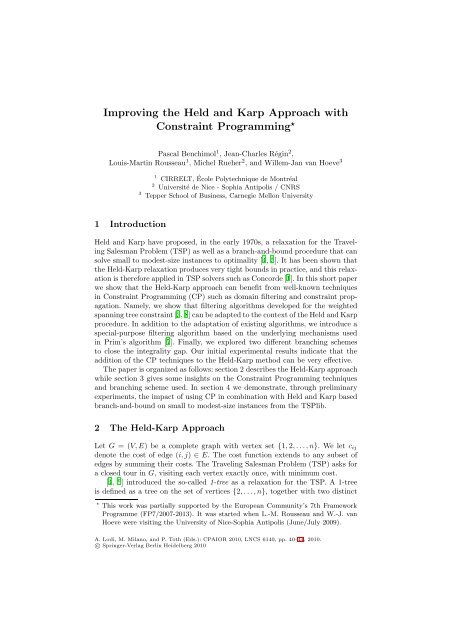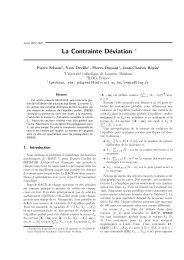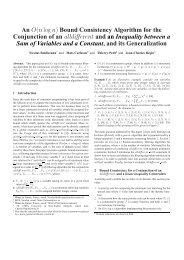Improving the Held and Karp Approach with Constraint Programming
Improving the Held and Karp Approach with Constraint Programming
Improving the Held and Karp Approach with Constraint Programming
Create successful ePaper yourself
Turn your PDF publications into a flip-book with our unique Google optimized e-Paper software.
<strong>Improving</strong> <strong>the</strong> <strong>Held</strong> <strong>and</strong> <strong>Karp</strong> <strong>Approach</strong> <strong>with</strong><br />
<strong>Constraint</strong> <strong>Programming</strong> ⋆<br />
Pascal Benchimol 1 ,Jean-CharlesRégin 2 ,<br />
Louis-Martin Rousseau 1 , Michel Rueher 2 , <strong>and</strong> Willem-Jan van Hoeve 3<br />
1 CIRRELT, École Polytechnique de Montréal<br />
2 Université de Nice - Sophia Antipolis / CNRS<br />
3 Tepper School of Business, Carnegie Mellon University<br />
1 Introduction<br />
<strong>Held</strong> <strong>and</strong> <strong>Karp</strong> have proposed, in <strong>the</strong> early 1970s, a relaxation for <strong>the</strong> Traveling<br />
Salesman Problem (TSP) as well as a branch-<strong>and</strong>-bound procedure that can<br />
solve small to modest-size instances to optimality [4, 5]. It has been shown that<br />
<strong>the</strong> <strong>Held</strong>-<strong>Karp</strong> relaxation produces very tight bounds in practice, <strong>and</strong> this relaxation<br />
is <strong>the</strong>refore applied in TSP solvers such as Concorde [1]. In this short paper<br />
we show that <strong>the</strong> <strong>Held</strong>-<strong>Karp</strong> approach can benefit from well-known techniques<br />
in <strong>Constraint</strong> <strong>Programming</strong> (CP) such as domain filtering <strong>and</strong> constraint propagation.<br />
Namely, we show that filtering algorithms developed for <strong>the</strong> weighted<br />
spanning tree constraint [3, 8] can be adapted to <strong>the</strong> context of <strong>the</strong> <strong>Held</strong> <strong>and</strong> <strong>Karp</strong><br />
procedure. In addition to <strong>the</strong> adaptation of existing algorithms, we introduce a<br />
special-purpose filtering algorithm based on <strong>the</strong> underlying mechanisms used<br />
in Prim’s algorithm [7]. Finally, we explored two different branching schemes<br />
to close <strong>the</strong> integrality gap. Our initial experimental results indicate that <strong>the</strong><br />
addition of <strong>the</strong> CP techniques to <strong>the</strong> <strong>Held</strong>-<strong>Karp</strong> method can be very effective.<br />
The paper is organized as follows: section 2 describes <strong>the</strong> <strong>Held</strong>-<strong>Karp</strong> approach<br />
while section 3 gives some insights on <strong>the</strong> <strong>Constraint</strong> <strong>Programming</strong> techniques<br />
<strong>and</strong> branching scheme used. In section 4 we demonstrate, through preliminary<br />
experiments, <strong>the</strong> impact of using CP in combination <strong>with</strong> <strong>Held</strong> <strong>and</strong> <strong>Karp</strong> based<br />
branch-<strong>and</strong>-bound on small to modest-size instances from <strong>the</strong> TSPlib.<br />
2 The <strong>Held</strong>-<strong>Karp</strong> <strong>Approach</strong><br />
Let G =(V,E) be a complete graph <strong>with</strong> vertex set {1, 2,...,n}. Weletc ij<br />
denote <strong>the</strong> cost of edge (i, j) ∈ E. The cost function extends to any subset of<br />
edges by summing <strong>the</strong>ir costs. The Traveling Salesman Problem (TSP) asks for<br />
aclosedtourinG, visiting each vertex exactly once, <strong>with</strong> minimum cost.<br />
[4, 5] introduced <strong>the</strong> so-called 1-tree as a relaxation for <strong>the</strong> TSP. A 1-tree<br />
is defined as a tree on <strong>the</strong> set of vertices {2,...,n}, toge<strong>the</strong>r <strong>with</strong> two distinct<br />
⋆ This work was partially supported by <strong>the</strong> European Community’s 7th Framework<br />
Programme (FP7/2007-2013). It was started when L.-M. Rousseau <strong>and</strong> W.-J. van<br />
Hoeve were visiting <strong>the</strong> University of Nice-Sophia Antipolis (June/July 2009).<br />
A. Lodi, M. Milano, <strong>and</strong> P. Toth (Eds.): CPAIOR 2010, LNCS 6140, pp. 40–44, 2010.<br />
c○ Springer-Verlag Berlin Heidelberg 2010
<strong>Improving</strong> <strong>the</strong> <strong>Held</strong> <strong>and</strong> <strong>Karp</strong> <strong>Approach</strong> <strong>with</strong> <strong>Constraint</strong> <strong>Programming</strong> 41<br />
edges incident to vertex 1. The degree of a vertex is <strong>the</strong> set of edges in <strong>the</strong> 1-tree<br />
incident to that vertex, <strong>and</strong> we denote it by deg(i) fori ∈ V . To see that <strong>the</strong><br />
1-tree is a relaxation for <strong>the</strong> TSP, observe that every tour in <strong>the</strong> graph is a 1-tree,<br />
<strong>and</strong> if a minimum-weight 1-tree is a tour, it is an (optimal) solution to <strong>the</strong> TSP.<br />
Note that <strong>the</strong> 1-tree is a tour if <strong>and</strong> onlng y if all <strong>the</strong> degree of vertices is two.<br />
The iterative approach proposed by [4, 5], uses Lagrangian relaxation to<br />
produce a sequence of connected graphs which increasingly resemble tours. We<br />
start by computing an initial minimum-weight 1-tree, by computing a minimumspanning<br />
tree on G \{1}, <strong>and</strong> adding <strong>the</strong> two edges <strong>with</strong> lowest cost incident<br />
to vertex 1. If <strong>the</strong> optimal 1-tree is a tour, we have found an optimal tour.<br />
O<strong>the</strong>rwise, <strong>the</strong> degree constraint one some of <strong>the</strong> vertices must be violated, i.e.,<br />
it is not equal to two. In that case, we proceed by penalizing <strong>the</strong> degree of such<br />
vertices to be different from two by perturbing <strong>the</strong> edge costs of <strong>the</strong> graph, as<br />
follows. For each vertex i ∈ V , a ‘node potential’ π i is introduced, Then, for each<br />
edge (i, j) ∈ E, <strong>the</strong>edgeweight˜c ij is defined as ˜c ij = c ij +π i +π j . [4] show that<br />
<strong>the</strong> optimal TSP tour is invariant under <strong>the</strong>se changes, but <strong>the</strong> optimal 1-tree<br />
is not. Once choice for <strong>the</strong> node potentials is to define π i =(2− deg(i)) · C, for<br />
a fixed constant C. The <strong>Held</strong>-<strong>Karp</strong> procedure re-iterates by solving <strong>the</strong> 1-tree<br />
problem <strong>and</strong> perturbing <strong>the</strong> edge costs until it reaches a fixed point or meets a<br />
stopping criterion. The best lower bound, i.e., <strong>the</strong> maximum among all choices<br />
of <strong>the</strong> node potentials, is known as <strong>the</strong> <strong>Held</strong>-<strong>Karp</strong> bound <strong>and</strong> will be denoted<br />
by HK.<br />
The overall <strong>Held</strong>-<strong>Karp</strong> approach solves <strong>the</strong> TSP through branch-<strong>and</strong>-bound,<br />
a technique that has been widely used on this problem (see [2] for a survey).<br />
A good upper bound, UB, can be computed easily <strong>with</strong> any of <strong>the</strong> popular<br />
heuristics that have been devised for this problem, e.g., [6].<br />
3 <strong>Improving</strong> <strong>the</strong> <strong>Approach</strong> Using CP<br />
In this section we describe <strong>the</strong> different refinements introduced to <strong>the</strong> original<br />
<strong>Held</strong>-<strong>Karp</strong> approach [4, 5], which consist of two filtering procedures based on <strong>the</strong><br />
weighted minimum spanning tree (or 1-tree), <strong>and</strong> one based on <strong>the</strong> underlying<br />
structure of Prim’s algorithm.<br />
In <strong>the</strong> following procedures let T be a minimum 1-tree of G computed by <strong>the</strong><br />
<strong>Held</strong> <strong>and</strong> <strong>Karp</strong> relaxation described above. For a subset of edges S ⊆ E, welet<br />
w(S) denote ∑ e∈S c e <strong>and</strong> T (e) be <strong>the</strong> minimum 1-tree where e is forced into T .<br />
We note that <strong>the</strong> filtering in subsection 3.1 has been applied to <strong>the</strong> weighted<br />
minimum spanning tree constraint in [3, 8], <strong>and</strong> <strong>the</strong> filtering in subsection 3.2<br />
has been applied to <strong>the</strong> weighted minimum spanning tree constraint in [3].<br />
3.1 Removing Edges Based on Marginal Costs<br />
The marginal cost of an edge e in T is defined as c ′ e = w(T (e)) − w(T ), that is,<br />
<strong>the</strong> marginal increase of <strong>the</strong> weight of <strong>the</strong> minimum 1-tree if e is forced in <strong>the</strong><br />
1-tree.
42 P. Benchimol et al.<br />
The following algorithm can compute, in O(mn), <strong>the</strong> marginal costs for edges<br />
e ∉ T . Each non-tree edge e =(i, j) links two nodes i, j, <strong>and</strong> defines a unique i-j<br />
path, say P e ,inT . The replacement cost of (i, j) is defined by c e − max(c a |a ∈<br />
P e ), that is <strong>the</strong> cost of (i, j) minus <strong>the</strong> cost of largest edge on <strong>the</strong> path from i to<br />
j in <strong>the</strong> 1-tree T . Finding P e can be achieved through DFS in O(n) for all <strong>the</strong><br />
O(m) edges not in T .IfHK+c ′ e > UB, <strong>the</strong>n e can be safely removed from E.<br />
3.2 Forcing Edges Based on Replacement Costs<br />
Conversely, it is possible to compute <strong>the</strong> replacement cost of an edge e ∈ T as<br />
<strong>the</strong> increase <strong>the</strong> <strong>Held</strong>-<strong>Karp</strong> bound would incur if e would be removed from E,<br />
which we define by c r e = w(T \ e) − w(T ).<br />
This computation can be performed for all edges e ∈ T , <strong>with</strong> <strong>the</strong> following<br />
algorithm: a) set all c r e = ∞∀e ∈ T b) for all e =(i, j) ∉ T identify <strong>the</strong> i-j<br />
path P e in T which joins <strong>the</strong> end-points of e. Update all edges a ∈ P e such<br />
that c r a = min(c r a,c e − c a ). This computation can be performed in O(mn), or,<br />
at no extra cost if performed toge<strong>the</strong>r <strong>with</strong> <strong>the</strong> computation of marginal costs.<br />
If HK + c r e − c e > UB, <strong>the</strong>n e is a m<strong>and</strong>atory edge in T .<br />
We note that such filtering has been applied to <strong>the</strong> weighted minimum spanning<br />
tree constraint by [3, 8].<br />
3.3 Forcing Edges Based during MST Computation<br />
Recall that Prim’s algorithm computes <strong>the</strong> minimum spanning tree in G (which<br />
is easily transformed into a 1-tree) in <strong>the</strong> following manner. Starting from any<br />
node i, it first partitions <strong>the</strong> graph into disjoints subsets S = {i} <strong>and</strong> ¯S = V \ i<br />
<strong>and</strong> creates an empty tree T . Then it iteratively adds to T <strong>the</strong> minimum edge<br />
(i, j) ∈ (S, ¯S), defined as <strong>the</strong> set of edges where i ∈ S <strong>and</strong> j ∈ ¯S, <strong>and</strong>movesj<br />
from ¯S to S.<br />
Since we are using MST computations as part of a <strong>Held</strong>-<strong>Karp</strong> relaxation to<br />
<strong>the</strong> TSP, we know that <strong>the</strong>re should be at least 2 edges in each possible (S, ¯S)<br />
of V (this property defines one of well known subtour elimination constraints of<br />
<strong>the</strong> TSP). Therefore, whenever we encounter a set (S, ¯S) thatcontainsonlytwo<br />
edges during <strong>the</strong> computation of <strong>the</strong> MST <strong>with</strong> Prim’s algorithm, we can force<br />
<strong>the</strong>se edges to be m<strong>and</strong>atory in T .<br />
3.4 Tuning <strong>the</strong> Propagation Level<br />
The proposed filtering procedures are quite expensive computationally, <strong>the</strong>refore<br />
it is interesting to investigate <strong>the</strong> amount of propagation that we wish to impose<br />
during <strong>the</strong> search. A first implementation consists in calling each filtering algorithm<br />
(as defined in sections 3.1, 3.2 <strong>and</strong> 3.3) only once before choosing a new<br />
branching variable. A second approach would be to repeat <strong>the</strong>se rounds of propagation<br />
until none of <strong>the</strong>se procedures is able to delete nor force any edge, that<br />
is reaching a fixed point. Finally, if reaching a fixed point allows to reduce <strong>the</strong><br />
overall search effort, a more efficient propagation mechanism could be developed<br />
in order to speed up its computation.
<strong>Improving</strong> <strong>the</strong> <strong>Held</strong> <strong>and</strong> <strong>Karp</strong> <strong>Approach</strong> <strong>with</strong> <strong>Constraint</strong> <strong>Programming</strong> 43<br />
3.5 Choosing <strong>the</strong> Branching Criterion<br />
Once <strong>the</strong> initial <strong>Held</strong>-<strong>Karp</strong> bound has been computed <strong>and</strong> <strong>the</strong> filtering has been<br />
performed it is necessary to apply a branching procedure in order to identify <strong>the</strong><br />
optimal TSP solution. We have investigated two orthogonal branching schemes,<br />
both based on <strong>the</strong> 1-tree associated to <strong>the</strong> best <strong>Held</strong>-<strong>Karp</strong> bound, say T .These<br />
strategies consist in selecting, at each branch-<strong>and</strong>-bound node, one edge e <strong>and</strong><br />
splitting <strong>the</strong> search in two subproblems, one where e is forced in <strong>the</strong> solution <strong>and</strong><br />
one where it is forbidden. In <strong>the</strong> strategy out we pick e ∈ T <strong>and</strong> first branch on<br />
<strong>the</strong> subproblem where it is forbidden while in <strong>the</strong> strategy in we choose e ∉ T<br />
<strong>and</strong> first try to force it in <strong>the</strong> solution.<br />
Since <strong>the</strong>re are O(n)edgesinT <strong>and</strong> O(n 2 ) edges not in T , <strong>the</strong> first strategy will<br />
tend to create search trees which are narrower but also deeper than <strong>the</strong> second<br />
one. However, since <strong>the</strong> quality of <strong>the</strong> HK improves rapidly as we go down <strong>the</strong><br />
search tree, it is generally possible to cut uninteresting branches before we get to<br />
deep. Preliminary experiments, not reported here, have confirmed that strategy<br />
out is generally more effective than strategy in.<br />
Table 1. Results on TSPlib instances<br />
original HK 1-round fixpoint<br />
time BnB time BnB time BnB<br />
burma14 0.1 28 0 0 0 0<br />
ulysses16 0.16 32 0 0 0 0<br />
gr17 0.14 34 0 0 0.01 0<br />
gr21 0.16 42 0 0 0.01 0<br />
ulysses22 0.19 0 0 0 0.01 0<br />
gr24 0.23 44 0.01 0 0.03 0<br />
fri26 0.36 48 0.01 2 0.01 2<br />
bayg29 0.35 54 0.04 6 0.07 6<br />
bays29 0.33 88 0.05 10 0.1 10<br />
dantzig42 0.65 92 0.09 4 0.17 4<br />
swiss42 0.79 112 0.09 8 0.09 8<br />
att48 1.7 140 0.21 18 0.23 15<br />
gr48 94 13554 5.18 2481 7.38 3661<br />
hk48 1.37 94 0.17 4 0.16 4<br />
eil51 15.9 2440 0.39 131 0.84 426<br />
berlin52 0.63 80 0.02 0 0.02 0<br />
brazil58 13 878 1.09 319 1.02 296<br />
st70 236 13418 1.21 183 1.1 152<br />
eil76 15 596 1.03 125 0.88 99<br />
rat99 134 2510 5.44 592 4.88 502<br />
kroD100 16500 206416 11 7236 50.83 4842<br />
rd100 67 782 0.76 0 0.73 0<br />
eil101 187 3692 8.17 1039 9.59 1236<br />
lin105 31 204 1.81 4 1.85 4<br />
pr107 41 442 4.65 45 4.49 48
44 P. Benchimol et al.<br />
4 Experimental Results<br />
To evaluate <strong>the</strong> benefits of using CP <strong>with</strong>in <strong>the</strong> <strong>Held</strong>-<strong>Karp</strong> branch-<strong>and</strong>-bound<br />
algorithm, we ran experiments on several instances of <strong>the</strong> TSPlib. We report<br />
both <strong>the</strong> number of branching nodes <strong>and</strong> CPU time required solve each instance,<br />
<strong>with</strong> different propagation levels: no propagation (‘original HK’), calling each<br />
filtering algorithm once (‘1-round’), <strong>and</strong> propagation until we reach a fixed point<br />
(‘fixpoint’). To eliminate <strong>the</strong> impact of <strong>the</strong> upper bound can have on search tree,<br />
we ran <strong>the</strong>se experiments using <strong>the</strong> optimal value of each instance as its UB.<br />
Table 1 clearly shows <strong>the</strong> impact of CP filtering techniques on <strong>the</strong> original<br />
<strong>Held</strong>-<strong>Karp</strong> algorithm. In fact <strong>the</strong> reduction of <strong>the</strong> graph not only considerably<br />
reduces <strong>the</strong> search effort (BnB nodes) but also sufficiently accelerates <strong>the</strong> computation<br />
of 1-trees inside <strong>the</strong> <strong>Held</strong>-<strong>Karp</strong> relaxation to completely absorb <strong>the</strong><br />
extra computations required by <strong>the</strong> filtering mechanisms. This can be seen as<br />
<strong>the</strong> proportional reduction in CPU times largely exceeds <strong>the</strong> reduction in search<br />
nodes.<br />
Finally, we cannot conclude that <strong>the</strong> extra effort required to reach <strong>the</strong> fixed<br />
point is worthwhile, as it is sometimes better <strong>and</strong> sometimes worse than a single<br />
round of filtering. Results on <strong>the</strong>se preliminary tests seem to show that more<br />
than one round of computation is most often useless, as <strong>the</strong> first round of filtering<br />
was sufficient to reach <strong>the</strong> fixed point in about 99.5% of <strong>the</strong> search nodes.<br />
More tests are thus required before investigating more sophisticated propagation<br />
mechanisms.<br />
References<br />
[1] Applegate, D.L., Bixby, R.E., Chvátal, V., Cook, W.J.: The Traveling Salesman<br />
Problem: A Computational Study. Princeton University Press, Princeton (2006)<br />
[2] Balas, E., Toth, P.: Branch <strong>and</strong> Bound Methods. In: Lawler, E.L., Lenstra, J.K.,<br />
Rinnooy Kan, A.H.G., Shmoys, D.B. (eds.) The Traveling Salesman Problem: A<br />
Guided Tour of Combinatorial Optimization, ch. 10. Wiley, Chichester (1985)<br />
[3] Dooms, G., Katriel, I.: The “not-too-heavy spanning tree” constraint. In: Van<br />
Hentenryck, P., Wolsey, L.A. (eds.) CPAIOR 2007. LNCS, vol. 4510, pp. 59–70.<br />
Springer, Heidelberg (2007)<br />
[4] <strong>Held</strong>, M., <strong>Karp</strong>, R.M.: The Traveling-Salesman Problem <strong>and</strong> Minimum Spanning<br />
Trees. Operations Research 18, 1138–1162 (1970)<br />
[5] <strong>Held</strong>, M., <strong>Karp</strong>, R.M.: The Traveling-Salesman Problem <strong>and</strong> Minimum Spanning<br />
Trees: Part II. Ma<strong>the</strong>matical <strong>Programming</strong> 1, 6–25 (1971)<br />
[6] Helsgaun, K.: An Effective Implementation of <strong>the</strong> Lin-Kernighan Traveling Salesman<br />
Heuristic. European Journal of Operational Research 126(1), 106–130 (2000)<br />
[7] Prim, R.C.: Shortest connection networks <strong>and</strong> some generalizations. Bell System<br />
Tech. J. 36, 1389–1401 (1957)<br />
[8] Régin, J.-C.: Simpler <strong>and</strong> Incremental Consistency Checking <strong>and</strong> Arc Consistency<br />
Filtering Algorithms for <strong>the</strong> Weighted Spanning Tree <strong>Constraint</strong>. In: Perron, L.,<br />
Trick, M.A. (eds.) CPAIOR 2008. LNCS, vol. 5015, pp. 233–247. Springer, Heidelberg<br />
(2008)







